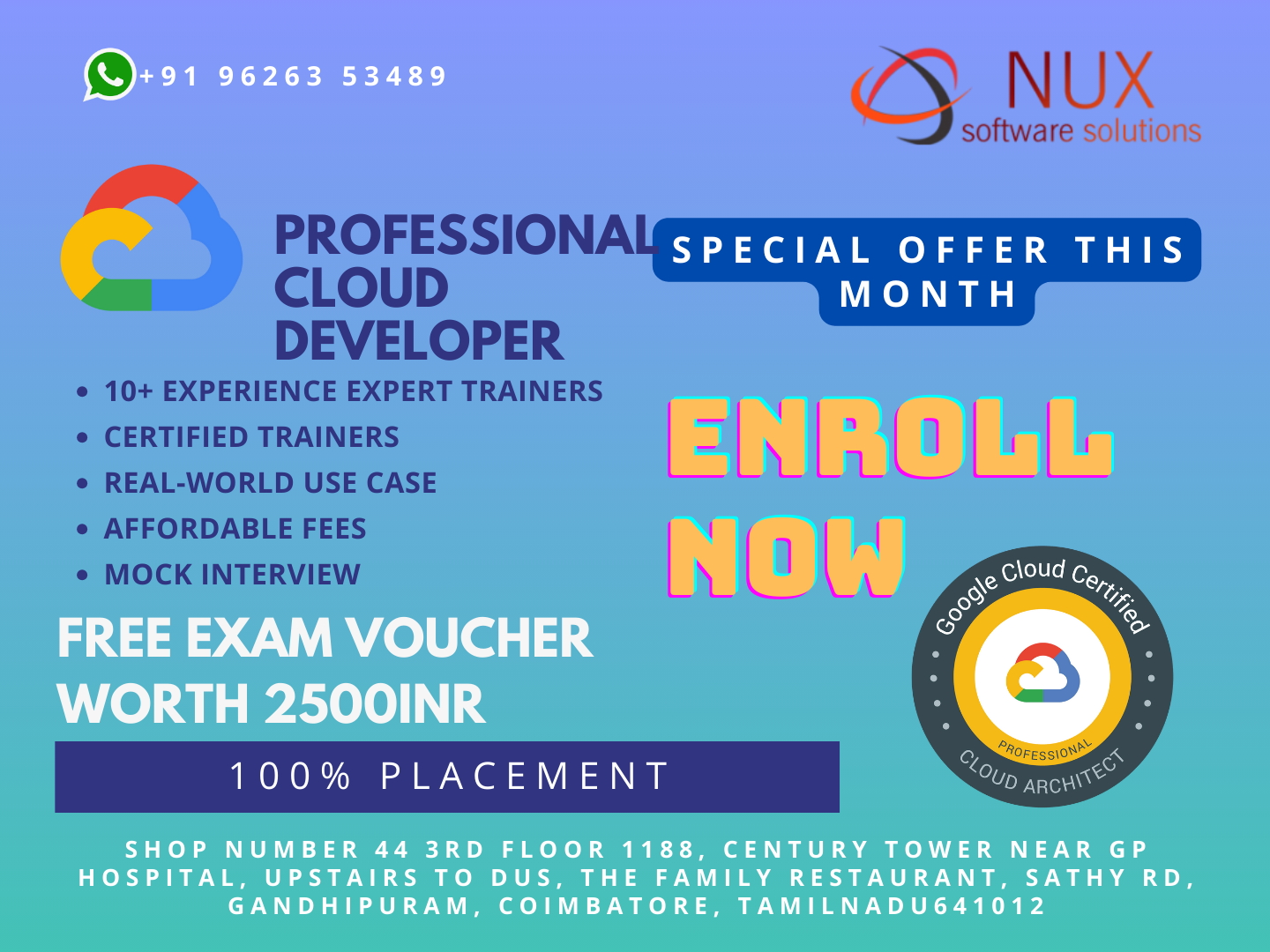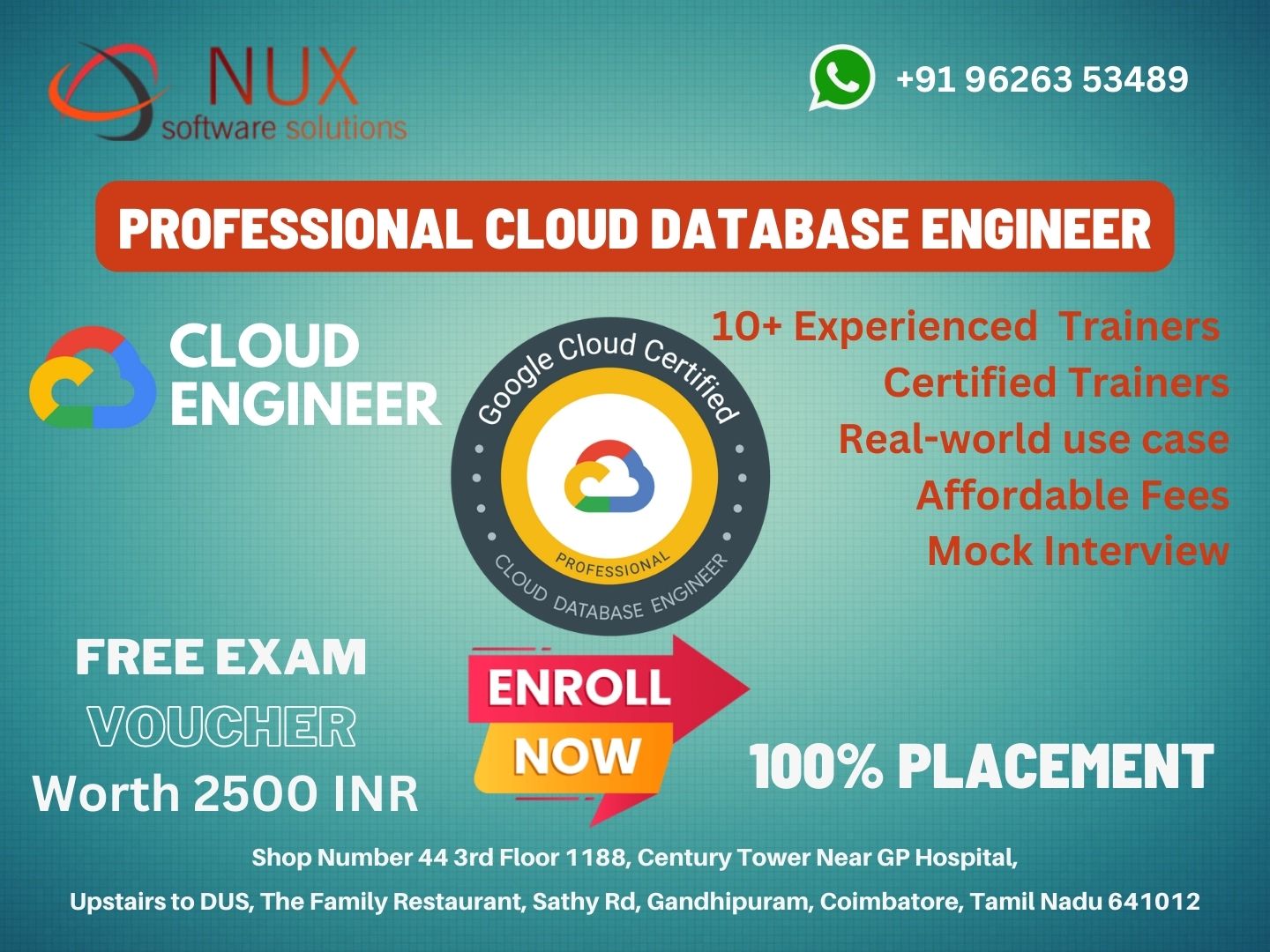Professional Cloud Developer


Best Professional Cloud Developer Training Institute in Coimbatore.
Nux software Training & Certification Solutions in Coimbatore offers a comprehensive and flexible training environment for aspiring cloud developers. The combination of expert trainers, advanced labs infrastructure, and a variety of training programs is an excellent formula for professional growth. The emphasis on hands-on experience and real-world projects is a great way to prepare for the dynamic field of cloud development. If you have any specific questions, or if there’s anything else you’d like to know about cloud development or training, feel free to ask!
The Professional Cloud Developer certification, recognized as one of the highest-paying IT certifications by Global Knowledge, offers a program that equips you with essential skills for career advancement. The training is designed to support your preparation for the industry-acknowledged Google Cloud Professional Cloud Developer certification
Get hands-on experience deploying solution elements, covering infrastructure components like networks, systems, and application services. Dive into real-world scenarios with practical Qwiklabs projects.
Upon successful completion of this program, you will earn a certificate of completion to share with your professional network and potential employers.
To achieve Google Cloud certification, register for and pass the official exam. For more details and preparation resources, visit Nux Software Training & Certification Solutions.
Course Syllabus
Professional Cloud Developer Syllabus
Designing highly scalable, available, and reliable cloud-native applications
- Microservices
- Scaling velocity characteristics/trade-offs of IaaS (infrastructure as a service) vs. CaaS (container as a service) vs. PaaS (platform as a service)
- Geographic distribution of Google Cloud services (e.g., latency, regional services, zonal services)
- Defining a key structure for high-write applications using Cloud Storage, Cloud Bigtable, Cloud Spanner, or Cloud SQL
- User session management
- Caching solutions
- Deploying and securing API services
- Loosely coupled asynchronous applications (e.g., Apache Kafka, Pub/Sub)
- Graceful shutdown on platform termination
- Google-recommended practices and documentation
- Implementing requirements that are relevant for applicable regulations (e.g., data wipeout)
- Security mechanisms that protect services and resources
- Security mechanisms that secure/scan application binaries and manifests
- Storing and rotating application secrets and keys (e.g., Cloud KMS, HashiCorp Vault)
- Authenticating to Google services (e.g., application default credentials, JSON Web Token (JWT), OAuth 2.0)
- IAM roles for users/groups/service accounts
- Securing service-to-service communications (e.g., service mesh, Kubernetes network policies, and Kubernetes namespaces)
- Running services with least privileged access (e.g., Workload Identity)
- Certificate-based authentication (e.g., SSL, mTLS)
- Google-recommended practices and documentation
- Defining database schemas for Google-managed databases (e.g., Firestore, Cloud Spanner, Cloud Bigtable, Cloud SQL)
- Choosing data storage options based on use case considerations, such as:
Time-limited access to objects
Data retention requirements
Structured vs. unstructured data
Strong vs. eventual consistency
Data volume
Frequency of data access in Cloud Storage
- Google-recommended practices and documentation
- Using managed services
- Refactoring a monolith to microservices
- Designing stateless, horizontally scalable services
- Google-recommended practices and documentation
Building and Testing Applications
- Emulating Google Cloud services for local application development
- Creating Google Cloud projects
- Using the command-line interface (CLI), Google Cloud Console, and Cloud Shell tools
- Using developer tooling (e.g., Cloud Code, Skaffold)
- Algorithm design
- Modern application patterns
- Software development methodologies
- Debugging and profiling code
- Unit testing
- Integration testing
- Performance testing
- Load testing
- Source control management
- Creating secure container images from code
- Developing a continuous integration pipeline using services (e.g., Cloud Build, Container Registry) that construct deployment artifacts
- Reviewing and improving continuous integration pipeline efficiency
Deploying applications
- Blue/green deployments
- Traffic-splitting deployments
- Rolling deployments
- Canary deployments
- Installing an application into a virtual machine (VM)
- Managing service accounts for VMs
- Bootstrapping applications
- Exporting application logs and metrics
- Managing Compute Engine VM images and binaries
- Deploying a containerized application to GKE
- Managing Kubernetes RBAC and Google Cloud IAM relationships
- Configuring Kubernetes namespaces
- Defining workload specifications (e.g., resource requirements)
- Building a container image using Cloud Build
- Configuring application accessibility to user traffic and other services
- Managing container life cycle
- Define Kubernetes resources and configurations
- Cloud Functions that are triggered via an event from Google Cloud services (e.g., Pub/Sub, Cloud Storage objects)
- Cloud Functions that are invoked via HTTP
- Securing Cloud Functions
- Creating a service account according to the principle of least privilege
- Downloading and using a service account private key file
Integrating Google Cloud Services
- Read/write data to/from various databases (e.g., SQL)
- Connecting to a data store (e.g., Cloud SQL, Cloud Spanner, Firestore, Cloud Bigtable)
- Writing an application that publishes/consumes data asynchronously (e.g., from Pub/Sub)
- Storing and retrieving objects from Cloud Storage
- Implementing service discovery in GKE and Compute Engine
- Reading instance metadata to obtain application configuration
- Authenticating users by using OAuth2.0 Web Flow and Identity-Aware Proxy
- Authenticating to Cloud APIs with Workload Identity
- Enabling a Cloud API
- Making API calls using supported options (e.g., Cloud Client Library, REST API or gRPC, APIs Explorer) taking into consideration:
Batching requests
Restricting return data
Paginating results
Caching results
Error handling (e.g., exponential backoff)
- Using service accounts to make Cloud API calls
Managing Application Performance Monitoring
- Debugging a custom VM image using the serial port
- Diagnosing a failed Compute Engine VM startup
- Sending logs from a VM to Cloud Logging
- Viewing and analyzing logs
- Inspecting resource utilization over time
- Configuring logging and monitoring
- Analyzing container life cycle events (e.g., CrashLoopBackOff, ImagePullErr)
- Viewing and Analyzing logs
- Writing and exporting custom metrics
- Using external metrics and corresponding alerts
- Configuring workload autoscaling
- Creating a monitoring dashboard
- Writing custom metrics and creating log-based metrics
- Using Cloud Debugger
- Reviewing stack traces for error analysis
- Exporting logs from Google Cloud
- Viewing logs in the Google Cloud Console
- Reviewing application performance (e.g., Cloud Trace, Prometheus, OpenTelemetry)
- Monitoring and profiling a running application
- Using documentation, forums, and Google Cloud suppor



